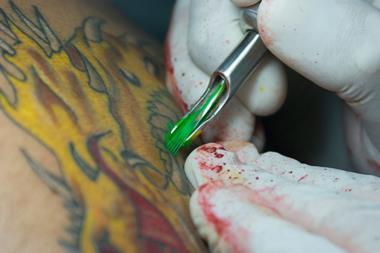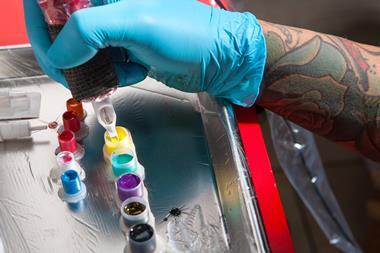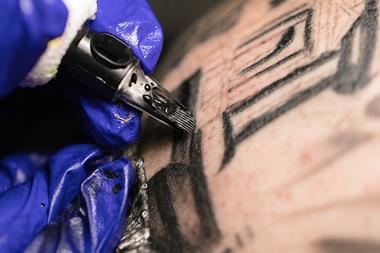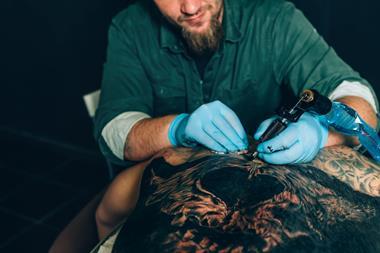An analysis of almost 100 tattoo inks in the US, including examining the particle size and molecular composition of their pigments, has turned up concerning ingredients that are not listed by manufacturers. These inks are manufactured in the US and then shipped around the world.
The research, led by chemist John Swierk at Binghamton University in the US, was presented at the autumn meeting of the American Chemical Society (ACS). Swierk’s team discovered azo-containing dyes in 23 of 56 inks analysed. When intact many azo-pigments don’t pose health problems, but some of them can release carcinogenic aromatic amines.
Exposure to bacteria or ultraviolet light can cause these dyes to break down into compounds that are potentially carcinogenic, according to the European commission’s Joint Research Centre (JRC), which provides the EU with independent scientific advice.
Beyond the presence of azo-containing dyes, chemical analyses by the Binghamton team also revealed ethanol in one ink batch that was not listed on the label. In addition, particles smaller than 100 nanometres in diameter were found in roughly half of 16 inks the researchers examined.
‘When you get down to that size range, you start to have concerns about nanoparticles penetrating cells, getting into the nucleus of those cells, doing damage and causing problems like cancer,’ Swierk said.
Limited knowledge
Initially, his team was interested in studying tattoos as medical diagnostic tools, but it soon became apparent that understanding about the interaction between light and tattoo ink is severely lacking, mostly due to limited knowledge about the inks’ composition. In the US, tattoo ink manufacturers aren’t required to disclose all of the ingredients in their products, and there is almost no oversight to ensure the accuracy of any such disclosures.
‘And so, both from a sense of our own intellectual curiosity in terms of what’s actually in the inks and to enable our own research into how light causes tattoos to fade, we began to study what is in tattoo inks,’ Swierk recalled.
Typically, tattoo ink is comprised of one or more pigments and a carrier that helps to deliver these colours into the skin. The pigments can be either discreet molecules, or bulk compounds like titanium dioxide or iron oxide. Tattoo ink manufacturers may add other components to adjust the viscosity of the ink for artistic or other purposes.
Yolanda Hedberg, a chemist at Western University in Canada with expertise is in corrosion science and the surface chemistry of materials, says the Binghamton study’s results are ‘reasonable’ and correspond with her previous findings. ‘I am not surprised about the finding that ingredients labels did not match actual content,’ she tells Chemistry World. Hedberg says she and her colleagues found something similar when they analysed 73 tattoo inks purchased in Sweden in 2020. They also concluded that the majority of the tattoo dyes and pigments belonged to the azo class.
Different regulatory approaches
Earlier this year, the EU effectively banned certain hazardous substances in tattoo inks, including two pigments that have been linked to bladder cancer.
The US Food and Drug Administration, however, does not regulate inks. Instead, local jurisdictions regulate the practice of tattooing. Inks aren’t even required to have an ingredients label in the US.
‘Anybody getting a tattoo, at least in the US, with blue and green tattoo inks should assume that … [they will include] these pigments that the EU has some concerns about,’ Swierk warned.
There is currently not too much difference between the inks sold in the US and the EU, according to Swierk . He expects that tattoo ink manufacturers will not produce specific US or European blends, but will instead just remove certain inks from sale in the EU if they contain ingredients banned there.
Beyond examining the composition of tattoo inks, Swierk and colleagues are also studying their effect on biological systems. Using human skin cell models, they are examining what happens to the pigments when they are exposed to light – how they break down and what they break down into, for example. The team is also studying the process of laser tattoo removal, and what breakdown products are produced by the process.
‘That relies, again, on understanding what are the pigments that are being used, and what are the other components in the inks that might come into play in these processes that might have toxicity to human cells, or allow for the growth of bacteria in inks,’ Swierk explained.
Swierk and undergraduates in his lab have also interviewed tattoo artists to determine their knowledge about the inks they use on their customers. Although they could quickly identify their preferred brand, they didn’t know much about its contents.
The researchers plan to complete the first comprehensive survey of tattoo inks in the US market, and will publish their results so that tattoo artists and consumers can make informed decisions. They will eventually post the data on a website that they have created called whatsinmyink.com.
‘Given the fact that this industry – especially in North America – is largely non-regulated and the same pigments are used as for industrial applications, it is time to at least require accurate and honest information on contents,’ Hedberg says.

















No comments yet